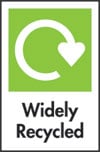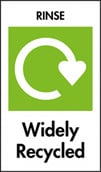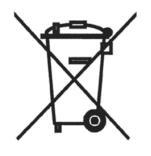Packaging Symbols Explained
We all know the drill; we all think we know what can and can’t be recycled but sometimes we need a little help. Luckily the symbols are there to explain whether that product/packaging can go into that big green bin (or any other colour a recycling bin can be!). However, have you ever actually stopped to read what that symbol means – No? Us neither. Up until now, we’ve gone through and taken the time to explain each symbol so you don’t have too. Why not print this out and put above the bin just to remind you and the family of each little thing.
| Symbol | Explanation |
Widely Recycled  |
Label applied to packaging collected by over 75% or more of local authorities across the UK. |
Widely Recycled – Rinse  |
Label applied to packages that need rinsing to ensure any food residue do not contaminate other packaging |
The Green Dot  |
Does not necessarily mean that the product packaging is recyclable, has been recycled or will be recycled. It signifies that the producer has made a financial contribution to recycling and recovery of packaging overall. |
Mobius Loop  |
Indicates an object is capable of being recycled not that it has been recycled or that it will be recycled as it may not be accepted in all recycling collection systems |
Plastic Resin Codes  |
Identifies the type of plastic resin used to make the item by providing a resin identification code. This is represented with chasing arrows symbol. Surrounding a number between 1-7 defining the resin used |
Mixed Glass  |
This indicates that this bottle/jar should be disposed of at a bottle bank or by using the household glass recycling collection if you have one |
Recycalable Aluminium  |
Indicates that the item is made from recyclable aluminium. |
Recycalable Steel  |
Indicates the item is made from recyclable steel. All local authorities collect steel cans for recycling however all types of other steel or metal items need to be taken to your local household recycling centre |
Tidyman  |
The symbol is from the campaign Keep Britain Tidy. It asks you not to littler. Does not relate to recycling but acts as a reminder to be a good citizen and disposing of the item in the most appropriate manner. |
Waste Electricals  |
This symbol explains that you should not place the items in your general waste bin. They should be recycled through a number of alternate channels |
Compostable  |
Products certified to be industrially compostable according to European standard. Never place compostable plastic into the recycling with other plastics; as it is designed to break down it cannot be recycled and contaminates recyclable plastics. Plastics that carry this symbol can be recycled with your garden waste through your local authority. |
Home Composting  |
In addition to the seedling symbol for industrial composting you may see this symbol which indicates that the product is suitable for home recycling. |
Paper, Cardboard and Wood  |
This logo identifies wood-based products from well-managed forests independently certified in accordance with the rules of FSC |
However no need to worry about your rubbish when you order a skip with us as we’re experts in household and commercial waste management and recycling. Give us a call on 01235 760555 or email us at customerservices@mccarthymarland.co.uk for more information.
Can Bricks be Recycled?
Do you ever wonder how many bricks you see on any given day? The average home is made up of thousands of them – so on a walk down the average street, you could see more than half a million bricks!
The humble brick is such a prevalent construction material, thanks largely to it’s good looks, strength and ease of manufacture.
Traditionally, bricks are made of natural clays like shale, which are crushed and ground, mixed with water and then either extruded or moulded. The wet brick is then coated if required, before being allowed to dry. Finally, the brick is fired in a kiln to finish.
Sometimes the clay itself dictates the colour – but additives can be blended with the clay to produce different colours and improve the strength of the finished brick.
But like everything else, bricks have a working lifetime; so what happens when it’s time to dispose of bricks?
Recycling, Restoring and Reusing Bricks
Most of the time, old bricks are in good enough shape to be reused as they are – and weathering, lichen and subtle variation is actually quite desirable in restoration projects. Reclaimed bricks must be completely intact in order to be passed on.
But thankfully, there’s still plenty of value left in damaged bricks.
Aggregate and Drainage Media
Heavily damaged bricks can be recycled into new materials: like aggregates for use as backfill or as a sub-base for roads.
Recycled bricks can be crushed and processed – to make tennis court surfaces, running tracks – or even as starting material for new bricks.
But there are some limits to what bricks can be recycled; contaminated bricks, like those used in conjunction with plasterboard or asbestos, are usually too difficult to clean – and must be disposed of responsibly.
Skip Disposal for Bricks
Dispose of your DIY waste with reliable skip hire from McCarthy. We can often provide next day delivery on skip hire services (subject to availability).
Let’s talk about your project; call 01235 760555 or fill out our contact form.
How is Metal Recycled?
Without even thinking about it, we produce huge quantities of metal waste in our everyday lives. Drinks cans, food cans, aluminium foil – and there’s even more metal waste in old electronics and demolished buildings. Find out more about how metal is recycled and what the challenges are.
Commonly Recycled Metals
Aluminium
Aluminium is probably the most well-known metal. It’s the main material used in fizzy drinks cans, a familiar and common household item. Aluminium has an enormous range of uses: from aeroplanes and Formula 1 cars to bicycles and window fascias. It’s extremely lightweight and rigid, but it’s a soft material that needs to be blended into an alloy to gain strength.
Steel
When iron is combined with carbon, it becomes steel: it’s much stronger than iron and less prone to corrosion when mixed with other metals. You’ll find plenty of steel in kitchens – from cutlery to appliances. Even food cans are made of coated steel. Because of its enormous tensile strength, steel is a common construction material found in all manner of buildings.
Copper
Plumbing and electrical wiring are made of copper. It’s one of the most common metals in manufacturing and it has fantastic conductive properties, which makes it good for electrics and cooking – but it’s really expensive. The price of copper makes it an attractive recycling material.
Brass
This alloy of copper and zinc has a distinctively dull golden colour. It’s heavy and strong but malleable, and doesn’t tarnish easily. It’s also resonant, which makes it an excellent material for musical instruments like horns and cymbals. Most commonly, it’s used to make taps, door handles and keys. The presence of copper makes it valuable, so it’s frequently recycled.
Gold
Everyone knows gold is valuable, but not that it’s in just about every electronic device in the world. Gold is an excellent conductor of electricity and almost immune to corrosion, which is why it’s used for contact points in devices. Gold is rare, so even when recycled it retains a high value: but it’s very hard to separate from other components in devices, which often makes the process unprofitable without specialist equipment.
Which Metals Can’t be Recycled?
Practically every metal can be recycled, but some metals are more challenging to extract than others. Gold, for instance, is present in electronic devices but in such small quantities that its removal is often not worth the effort. Paint cans and oil cans are difficult to recycle due to contamination, where the contents have impregnated the metal.
Dangerous Metals
Lead was once used for water pipes and in pubs – before it was found to be poisonous to humans. It’s still a commonly used metal in roofing, because it’s soft and resistant to corrosion. It’s valuable, so it’s usually recovered and sold on as-is. Lead in paints and older electric devices is not recyclable.
What Happens to a Fizzy Drink Can When it’s Recycled?
So, now we know more about metal recycling, how is metal recycled? There are a few different methods for different materials – but let’s look at one of the most common examples: an aluminium drinks can.
First, the can is collected – usually mixed in with other household recycling. Everything gets taken to the recycling centre for sorting, separating everything into groups. All aluminium drinks cans are grouped into the same conveyer belt. Next, they’re crushed into sheets or shredded for easier processing before heading into a furnace for melting.
Next, the aluminum goes into a furnace, specifically heated to melt aluminium. Once completely liquified, the aluminium is purified by scraping off the dross and degassing it, sometimes using chemical additives to accelerate the process. The metal is then cast into an easily transportable and stored shape, such as an ingot, before being cooled.
The purified aluminium will go on to become new cans, cars, planes – anything at all that calls for lightweight aluminium!
Expert Metal Recycling
We’re experts in household and commercial metal recycling. For more information, contact McCarthy – call 01235 760555 or order a skip online!
Plastic Disposal – is it Safe to Burn?
No, plastic is not safe to burn – so please don’t do it. Thankfully, there are plenty of other options to consider if you need to dispose of plastics, all of which are safer and less time-consuming.
Why is Burning Plastic Unsafe?
When plastic burns, it releases a suite of dangerous chemicals; carbon monoxide, hydrochloric acid, sulfur dioxide – even heavy metals. These gases can seriously damage health in both the short and long term, and reduce air quality. Indoors, even in a fireplace or ventilated area, you’d create a toxic soup and the adverse effects would come on quite quickly.
Far worse, burning plastics collapse into a bubbling, molten goo. Bubbling plastic can spit and pop – closed plastic bottles can even explode – which can send the molten liquid outwards. If this unbelievably hot, sticky plastic comes into contact with a person, it can cause incredible pain and severe burns.
It sticks to the skin tightly, and peeling it off can take the skin with it. It’s really nasty stuff that you don’t want to get anywhere near to.
So please, don’t burn plastic – besides, there’s so much more you can do with it anyway!
Recycle Plastic
The best thing to do with plastic is to recycle it. Plastic is one of the slowest materials to decompose – taking up to 1,000 years to break down – which makes it one of the worst waste materials to end up in landfill.
Recycling helps to keep plastic out of landfill, waterways and the ecosystem at large – and it stems the creation of new plastic from raw materials.
But even recycling takes energy and further resources. So, while it’s still the best way to deal with bulk plastics, smaller steps can start at home.
Reuse or Upcycle Plastic
Bottles, takeaway containers and bags can all be used multiple times, and for multiple purposes – keeping them out of the bin for longer. Further life can be breathed into plastic items by upcycling them; making a used plastic bottle into a bird feeder, garden sprinkler or desk tidy makes use of them long after they’ve served their initial purpose.
Landfill is Still Better than Burning
Although it’s still not great, landfill is a better option than burning – which is testament to just how bad burning plastic really is. Landfill keeps plastic contained for at least enough time
A Sustainable Future – with Plastic
At McCarthy, we’re always reviewing our plastic recycling processes, to guarantee our methods are as efficient and as sustainable as possible. We continue to invest in our goal: achieving 100% recycling rates.
Find out more information about our waste management solutions, skip hire and plastic recycling methods – contact us.
7 Things You Didn’t Know About Cardboard Recycling
Thanks to recycling schemes taking hold all over the UK, cardboard recycling takes place in just about every home. Now that it’s easier than ever before, more people are doing their bit for a sustainable planet.
Having just celebrated the festive season and to show our appreciation for the wonderful material that makes gift boxes, Amazon packages and Christmas crackers possible, here are some of our favourite cardboard recycling facts.
A Billion Christmas Cards and Counting
Back in 2004, 744 million Christmas cards were sent in the UK. In 2016, it was estimated that a billion christmas cards were sold (not including from online retailers). If all of those cards were recycled, it could have saved 333,000 trees.
Corrugated Cardboard is the Most Recycled Packaging
84% of all corrugated cardboard is recycled in the UK – that adds up to about 2 million tonnes of the stuff saved from landfill every year! That only counts corrugated card specifically – not other types of card stock which have a significantly lower recycle rate.
Luckily, corrugated card is one of the most widely used packaging materials in the world, so the chances are the next box you get will be made of recycled materials – and then go on to become something else.
You Can’t Recycle Card Forever
After a few passes through the recycling process, paper and card fibres are too short to retain a structure and they wear out. The card recycling process can’t go on forever, which is why we still need to grow and fell trees. But it can reduce wastefulness, conserve energy and cut back on polluting chemicals. And since it’s made from wood pulp, it’s biodegradable anyway – so it’ll still have its uses.
Pizza Boxes Don’t Get Recycled
There’s surely no greater treat than a hot, cheesy pizza delivered to your front door. Just the thought of tucking into a slice of pizza is enough to make anyone change their dinner plans. But popping a used pizza box in your cardboard recycling is actually doing more harm than good.
Why? Well, all the grease from the cheese and toppings on the pizza filters down into the cardboard, making it extremely difficult to clean and reprocess. The fibres lose integrity and can’t be bound back together. And if the grease runs onto other cardboard items, it can ruin a whole binful!
It doesn’t mean you have to waste the box completely. Instead, tear sections off your pizza box for makeshift cardboard plates. It’ll save on washing up, which helps reduce emissions and water usage – and it’s always nice to have a break from the dishes once in a while!
7 Million Tonnes of Cardboard is Wasted to Landfill Yearly
12.5 million tonnes of paper and cardboard are used annually in the UK. If you factor in our current UK-wide recycling rate of 45%, we’re committing 7 million tonnes of that to landfill every year – that’s even heavier than the Great Pyramid of Giza.
Recycled Cardboard can Build a House
Peter Ryan from Melbourne, Australia, built a working house almost entirely out of cardboard.
Cardboard is Easier to Recycle than it is to Make
Cardboard is one of the most efficient materials to recycle. Making cardboard from scratch requires not only trees for wood, but also various industrial chemicals and vast amounts of energy.
Making new cardboard products from used cardboard cuts out the need for trees and the majority of the chemical treatment process. Because so much energy is conserved by recycling, cardboard takes far less effort to recycle than it does to make from scratch.
Talk to McCarthy About Bulk Recycling
McCarthy does recycling with a difference. With over 20 years of waste management experience, we’re here to deliver you a professional and environmentally-friendly service.
Our fully licensed recycling plant in Wantage, Oxfordshire, is equipped with the latest technology. Our experienced, dedicated team has helped us reach a recycling rate of 95% – and we continue to improve.
To see what difference we can make to you, give us a call on 01235 760555 or contact us.
Household Carpet Recycling: The Dos and Don’ts
An estimated 400,000 tonnes of carpet is consigned to landfill every year. That’s more than the mass of the Empire State Building in New York City. With such a huge amount of landfill being devoted to carpet waste, isn’t it time we reduced the impact that carpet disposal has on the planet?
The good news is that things are looking better already; carpet recycling rates are at an all-time high. Now that reusing, repurposing and recycling carpet is becoming more common, how can you make sure you’re doing it right?
What Kind of Carpet can be Recycled?
The truth is, any carpet can be reused or recycled. Both wool and synthetic carpet types are recycled by McCarthy and turned into a variety of new things – including surfaces for equestrian events and animal bedding.
Some carpets can be separated into backing and yarn. Synthetic carpet made with petrochemical plastics can be turned into injection moulded plastic products and unbacked woolen carpet makes an excellent insulator and an effective soil enrichment medium when shredded – due to its high nitrogen content.
Carpet tiles, for example, are extremely tough and hard wearing, which makes them ripe for reuse. After cleaning and matching, they can be sold on at a fraction of the price of new carpet tiles, with a long life ahead of them.
Carpet Recycling Dos and Don’ts
Let’s start with a don’t, because this one is common: Don’t try to chop up or shred old carpet into tiny pieces yourself. Although it may seem like a good, space-saving idea, it hinders the sorting process (which splits out carpets by woolen and synthetic types) and can make recycling impossible.
At McCarthy, carpet is sorted and baled by its type before being processed, so you can save effort and time by leaving it intact.
If you’ve got carpet to dispose of skip hire is a good option! McCarthy skips are available in a range of sizes, perfect for any DIY renovation or redecorating jobs you’ve got on – including laying new carpets!
McCarthy Recycling
McCarthy does waste management with a difference. With over 20 years of skip hire and waste management experience, we’re here to deliver you a professional and environmentally-friendly service.
Our fully licenced recycling plant in Wantage, Oxfordshire, is equipped with the latest technology. Our experienced, dedicated team has helped us reach a recycle rate of 95% – and we continue to improve.
To see what difference we can make to you, give us a call on 01235 760555 or contact us for a skip hire quote.